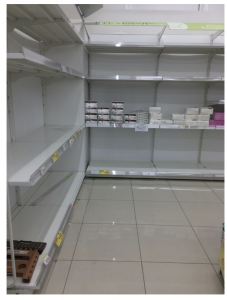
Panic or pandemic?
There’s the Coronavirus pandemic and then there’s the associated panic. Both will have an impact on near term investment returns and as I write this note, the ASX200 price index has swung 13 per cent down from its January high. But the pandemic and the panic will also provide level-headed investors with an opportunity.
While there’s a great deal we don’t know about Coronavirus and COVID-19, here we discuss some of those unknowns and the possibilities.
What we don’t know
We don’t know how many people will contract the virus. While the WHO increased their assessment of the risk of spread and the risk of impact of COVID-19 on February 28, 2020, to “very high at a global level” (if that’s not a declaration of a pandemic then nothing is), we cannot be certain of the quantum. Dr Marc Lipsitch, professor of epidemiology, Harvard T.H. Chan School of Public Health, Boston, estimates 40 per cent to 70 per cent of all adult Americans will ultimately be infected. That’s 130 – 229 million people and compares unfavourably to the 35 million US citizens who contracted the seasonal influenza virus last year.
Adding to the confusion, Lipsitch’s forecast compares horribly to the infection rate of 13 per cent on the Diamond Princess cruise ship.
The seasonal flu is not associated with reinfection. What we don’t know is whether an individual recovered from COVID-19 can be reinfected.
We are also still uncertain about the mortality rate or Case Fatality Rate. The Chinese Centre for Disease Control and Prevention, on 11 February, noted 1023 deaths amongst 44,415 laboratory-confirmed cases – equivalent to 2.3 per cent.
If the same 35-million Americans, those that caught the flu last year, contracted COVID-19, a 2.3 per cent mortality rate would mean 816,500 people will die. Last year there were 34,200 deaths from influenza. If Lipsitch is correct, and the mortality rate remains at 2.3 per cent, three million to five million Americans will die.
Another question we don’t have an answer to is whether warmer seasonal temperatures will end the spread of Coronavirus or merely slow it?
The problem for investors and for markets is the number of unknowns. In the absence of reliable data, investors cannot make confident forecasts about the future. In an environment that has no data to which to anchor, fear and uncertainty drive decision making. Many professional investors will reduce their risk any way their mandates permit and market volatility will become entrenched.
Only when reliable data is available will investors confidently look to the freedom beyond the fear.
What we can surmise
If a patient presents to their doctor with COVID-19, and the doctor responds reassuringly; “its ok we’ve cut interest rates”, the patient isn’t going to be cured.
With borders closing, travel being cancelled or postponed (see Image 1.), workers locked out or forced to stay home because their children’s schools have been closed, and with millions of people quarantined in their homes, rate cuts aren’t likely to inspire the ‘animal spirits’ that would normally act as a transmission mechanism between rate cuts and corporate investment and retail consumption.
We also know, as discussed above, that this Coronavirus has a much higher mortality rate than seasonal influenza and a higher infection rate. And SARS pales into insignificance on those same metrics. The combination of higher mortality and infection rates, understandably, inspires fear. But fear for the economy is not the issue. When consumers and citizens fear for their health, which they are now doing – noting the cancelled travel and disinfectant shortages – assumptions about normal market dynamics should be suspended.
As Images 1 and 2 reveals, there is a real impact on business from this outbreak. Sydney airport is virtually empty. Some international flights are departing Sydney at less than a third of capacity (some NZ flights are full) and toilet rolls are running off the shelves (Image 3. meme)

Image 1. Sydney Airport International Gate Lounge 06/03/20,13:00hrs

Image 2. Tokyo supermarket shelves

Figure 3. Social Media meme
We believe the cheaper prices at which to buy high quality companies is a distinct possibility in coming weeks.
Contagion
The real contagion for us, is not the virus itself but the possibility that fear in equities spreads to credit markets.
If the virus disrupts business for long enough to adversely impact the cash flows of highly indebted corporates, the desire to refinance a record amount of CCC-rated debt due this year could evaporate. Any tightening of liquidity could trigger a credit event or crisis. If a credit event does transpire, or even if the fear of such an event emerges, substantially lower shares prices are possible.
Beyond that of course, ‘this too will pass’. I can almost guarantee[1] that we won’t be talking about Coronavirus as an influence on the stock market in five years’ time. With that in mind, it makes perfect sense to be looking for opportunities among the malaise. And the lower the prices, the higher our return.
The last few weeks have been witness to turbulence unfamiliar to many investors, especially those that that only began investing professionally after the GFC. And some of the fastest declines in share prices ever have ruffled confidence, especially those in the camp that believed lower interest rates were supportive for asset prices (correct) and believed low interest rates created an immunity against market declines (incorrect).
As an aside, it is right to assume that low interest rates are supportive for asset prices, but it is wrong to conclude low interest rates make markets immune to falls.
And on top of all that the Federal Treasury suggests the bushfires and the virus could subtract 0.7 percentage points from Australia’s March quarter GDP growth. This would send the economy into reverse and if it continues into the last quarter of the financial year, an official recession is possible.
Positioning for the worst and positioning for the best
At The Montgomery Fund, the Montgomery [Private] Fund and the Montgomery Small Companies Fund, we used the strength in prices during January and early February to sell down some of our holdings and to raise our cash levels. By actively managing risk, we have been able to outperform index investing in February. The sell-off has highlighted the merit in a value investing approach that concentrates investments in higher quality businesses with bright prospects – something we have not lost sight of.
Thanks to yet another black swan event, our articles last year, warning investors about the unnecessary risks of investing in WAAAX stocks at stretched market prices, including Wisetech (now down 61 per cent), Appen (-33 per cent) and Altium (-31 per cent) should now serve as a reminder of the many genuine benefits of a patient approach to investing in high quality earnings when available at relatively cheap prices.
We currently believe that a risk of even lower prices exists. In the absence of reliable data and with the worst of the news flow and official responses potentially still ahead, the possibility of a panic worse than the pandemic is very high.
With that in mind and armed with cash, and a target list of quality companies, Montgomery is in an enviable position compared to fully invested peers.
Quality will remain important because not all stocks are going to bounce after the worst of the news flow is over. An investor in a portfolio of expensive, high beta, high hope, but low-quality companies, may not enjoy a substantial recovery.
If you hold doubts about what to do from here, consider the suitability of an actively risk-managed value investing portfolio such as those managed by Montgomery. Of course always seek personal professional advice.
Give Toby Roberts a call on (02) 8046 5017 or David Buckland on (02) 8046 5004.
[1] One can never actually guarantee.
You can read my next article here: How value investors could benefit from this market correction?
Dear Roger,
The biggest risk of coronavirus is a “relatively” short-term reduction in productivity as healthy young and middle aged workers are sidelined for short periods…..1 to 3 weeks.
Yes travel and overseas student based industries may have longer down times……months.
Without being callous the overall effect of a 3 to 5 % mortality rate will be to increase death rates in over 65 year olds. These people tend to spend less and consume less. They are more of a burden on governments through pensions and health care costs. Remember 90% of the life time expenditure on average for any human is in the last 2 to 3 years of their lives.
Think of the positive effect on the freeing up of the housing sector and making houses more affordable for young people if a significant portion of over 65 year olds succumb to this pandemic.
I say all of this as a doctor aged 66 years. It may well have very positive medium term effects on the Australian economy.
I wish no one ill health or harm……………but “too many people on earth”
Roger and Andrew, I think on this panic versus epidemic debate their is a mental hurdle to overcome which involves recognizing that both are simultaneously possible.
On one hand there are the more conservative/libertarian types who are quick to call this a panic – a bad flu, small in the scheme of things etc. Their instincts are mostly correct on most issues – when we see people panic it does mostly turns out that it was just panic and of course human beings and crowds are irrational.
However, in relation to COVID19, when I listen to the usual suspects present their arguments (those who say this is just a panic) they do not inspire me with confidence that they have the slightest idea that they know what they are talking about – they do not understand epidemiology, pathology, mathematical concepts such as exponential growth, the nature of health care provision and how practically difficult it is to deal with these situations – having health professionals treat the elderly affected by seasonal flue and having to dealing with COVID19 where these clinicians are being exposed to a high risk, day on day, for months on end and where they are potentially not backed by authorities and the pubic (in a milieu which is not set up to cope with this) – are two completely different things.
Imagine a situation where instead of fighting over toilet paper people are fighting over getting medical treatment for relatives who are seriously ill and that the health system simply cannot provide it. Imagine if health care professionals become so fatigue and so ill and frustrated that they can no longer provide care. In Wuhan health care professionals have been brought in from other areas but if this becomes a pandemic that is not possible.
The other possibility is that this virus could easily mutate so that it simultaneously becomes more virulent and more pathological – this is the horror scenario and is what happened with the Spanish Flu.
The point I making here is that though 99.9% are irrationally panicking that does not mean that on this occasion this is serious.
In relation to markets these types of crises undermine trust – a legitimization crises with the potential to expose a multitude of problem no least of which the generalized quality of our leadership and which has been populated by rank careerists.
Thanks John, I just gave two interviews for the ABC and said exactly that. But the pandemic and the panic will impact stock prices and company earnings.
Good work Roger.
Excellent article Roger, all the best to you and your team
thanks for the encouraging words Campbell